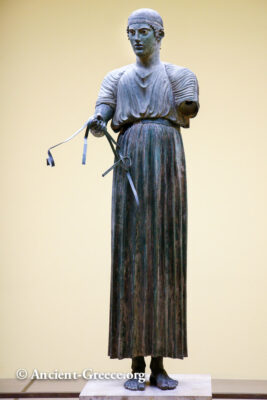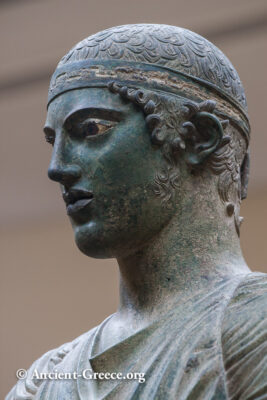
On this page:
The “Charioteer of Delphi” (Greek: Ἡνίοχος, meaning the rein-holder; often transliterated as Heniokhos or Iniohos“) is one of the best known ancient Greek statues, and one of the best preserved Classical bronze casts. It is considered a fine example of the Early Classical, or “Severe” style, which marks the beginning of transition between Archaic and Classical sculpture.
The sculpture depicts the driver of the chariot race at the moment when he presents his chariot and horses to the spectators in recognition of his victory.
Despite the gravity of the moment, the youth’s demeanor encapsulates the moment of glory with abundant reverence, and serenity. This humility captures the classical ideal “παν μέτρον αριστον” (roughly translated to mean nothing in excess, or every moderation is excellent), which extends to a person’s control over their emotions. Showing reverence for the moment not in excessive emotional display, but in respectful contemplation was one of the major ideals of classical Greece, and it is present in every cultural activity (with the exception of the Dionysea). In this case, the victor is in full control of his emotions—an ability that according to Greeks of the Classical era separates civilized humans from beasts.
Importance
The Charioteer of Delphi is one of the most important sculptures of ancient Greece partly because it vividly represents the passage from the Archaic conventions to the Classical ideals.
It exemplifies the balance between stylized geometric representation and idealized realism, thus capturing the moment in history when western civilization leaped forward to define its own foundations that nurtured it for the next few millennia.
Metaphorically, his gaze points to the upcoming historical developments of the Classical period with tranquility, confidence, and determination.
Description




Charioteer –though victorious– stands with admirable modesty and faces the crowd in total control of his emotions. This Self-discipline was a sign of civilized man in Classical Greece, and a concept that permeates the art of this period. The ability to restrain one’s emotions especially during the most challenging of moments came to define the entire Classical era of Greek art and thought.
The posture of the Charioteer is well balanced, and his long chiton drapes over his athletic body with architectural certainty, allowing idealism to flow through the serene parallel folds that run the length of his lower body before they begin to curl neatly over his torso. The geometric folds of the chiton overlie an obvious and well proportioned muscular body, thus achieving a rare harmony between idealism and realism.
The facial expression betrays none of the exuberance we would expect a victorious athlete to project, especially immediately following the race. Instead the athletic youth stands and stares with a natural ease that allows him to levitate in a realm between earthly and divine spaces. The statue’s eyelashes and lips are made of copper, while the head band in the shape of a meander is impressed in silver, and the eyes are made of onyx. These details bestow an understated luxury to the statue, while the carefully modeled curls of his wet hair and soft beard act as subtle clues to the preceding drama of the chariot race.



The Charioteer’s garment, the xystis, is the typical chiton that all chariot drivers wore during the race. It spans his whole body to his ankles, and is fastened high at the waist as was customary with a plain belt. The two straps that cross high at his upper back and round his shoulders are also typical of a chariot racer’s attire, and they prevent the xystis from “ballooning” and riding up his neck as the air is forced inside the chiton during the race.
The feet of the Charioteer have been modeled with scholarly realism, and exist not as a mere base for the statue, nor as a simple representation of human anatomy. Instead they act as the negotiator between the ground and the body. They instigate the delicate twist of the entire body, and infuse fluidity and lightness to the naturally heavy bronze mass.
Facts
The statue is dated to 470 BCE (Konsola, 32). The inscription on the surviving base parts indicates that the statue was commissioned by Polyzalus who was the tyrant of Gela–a Greek colony in Sicily–as tribute to Apollo for helping him win the chariot race during the Pythian games either in 478 or 474 BCE (Petracos, 42).

Charioteer was part of a complex of statues that included his four horses, a handler, and the chariot upon which he stood. What remains of the entire complex of statues besides the Charioteer is small parts of the horses and the reins as witnesses to the lost, grandiose, three dimensional composition.
With the exception of his missing left arm, the Charioteer statue is preserved in remarkable state. Most of the surface details are evident as the bronze patina has protected the statue for centuries when it was buried underground. Originally, the patina had a bluish hue that has turned green over the years. Part of the original bluish patina is still visible on the surface.
Today the Charioteer is exhibited in a dedicated room at the Delphi Museum. The tangled reins in his hand either show how the reins were unearthed, or they were placed this way by a creative restorer. In it’s original state, the reins were probably held taught between the hand and the bits. Whaterver the case, the tangled randomness of the reins provide a nice balance to the austere “architectural” posture of the statue, while adding an appealing modern incongruity to the otherwise orderly forms of the body and clothes.







